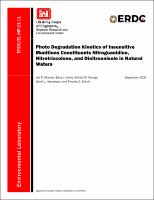Please use this identifier to cite or link to this item:
https://hdl.handle.net/11681/41900| Title: | Photo degradation kinetics of insensitive munitions constituents nitroguanidine, nitrotriazolone, and dinitroanisole in natural waters |
| Authors: | Moores, Lee C. Jones, Stacy J. George, Garrett W. Henderson, David L. Schutt, Timothy C. |
| Keywords: | Dinitroanisole Nitrotriazolone Nitroguanidine Photolysis Quantum yield Kinetics |
| Publisher: | Environmental Laboratory (U.S.) Engineer Research and Development Center (U.S.) |
| Series/Report no.: | Miscellaneous Paper (Engineer Research and Development Center (U.S.)) ; no. ERDC/EL MP-21-11 |
| Is Version Of: | Moores, Lee C., Stacy J. Jones, Garrett W. George, David L. Henderson, and Timothy C. Schutt. "Photo degradation kinetics of insensitive munitions constituents nitroguanidine, nitrotriazolone, and dinitroanisole in natural waters." Journal of Photochemistry and Photobiology A: Chemistry 386 (2020): 112094. https://doi.org/10.1016/j.jphotochem.2019.112094 |
| Abstract: | Herein the matrix effects on the kinetics of aqueous photolysis for the individual munitions constituents of IMX-101: nitroguanidine (NQ), dinitroanisole (DNAN), and nitrotriazolone (NTO) are reported along with the environmentally relevant kinetics and quantum yields. Photolysis potentially represents a major degradation pathway for these munitions in the environment and further understanding the complex matrices effects on photolytic kinetics was needed. Aqueous systems are of particular interest due to the high solubility of NQ (3,800 ppm) and NTO (16,642 ppm) compared to the traditional munitions trinitrotoluene (TNT, 100.5 ppm) and 1,3,5-trinitro-1,3,5-triazine (RDX, 59.9 ppm). Environmental half-lives (and quantum yields) were found to be 0.44 days, 0.83 days, and 4.4 days for NQ, DNAN, and NTO, respectively, under natural sunlight. In laboratory experiments using nominally 300 nm bulbs in a merry-go-round style reactor in DI water the relative rate of photolysis for the three munitions constituents followed the same order NQ > DNAN > NTO, where DNAN and NTO reacted 57 and 115 times more slowly, respectively, than NQ. In the various environmentally relevant matrices tested in the laboratory experiments NQ was not significantly affected, DNAN showed a faster degradation with increasing ionic strength, and NTO showed a modest salinity and pH dependence on its rate of photolysis. |
| Description: | Miscellaneous Paper |
| Gov't Doc #: | ERDC/EL MP-21-11 |
| Rights: | Approved for Public Release; Distribution is Unlimited |
| URI: | https://hdl.handle.net/11681/41900 http://dx.doi.org/10.21079/11681/41900 |
| Appears in Collections: | Miscellaneous Paper |
Files in This Item:
| File | Description | Size | Format | |
|---|---|---|---|---|
| ERDC-EL MP-21-11.pdf | 818.24 kB | Adobe PDF |  View/Open |